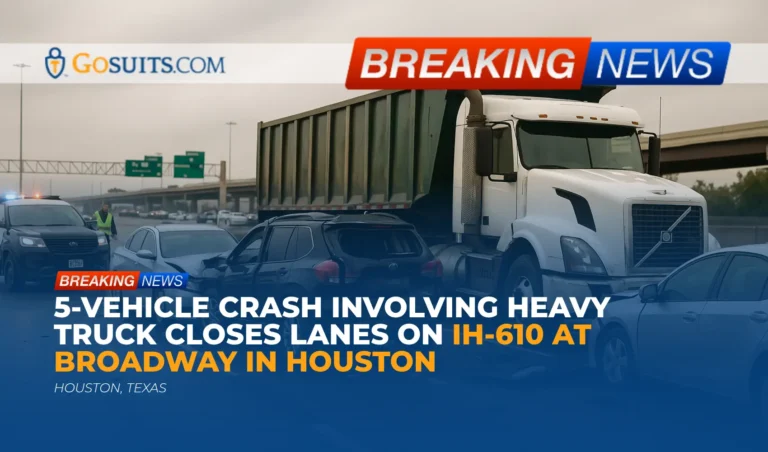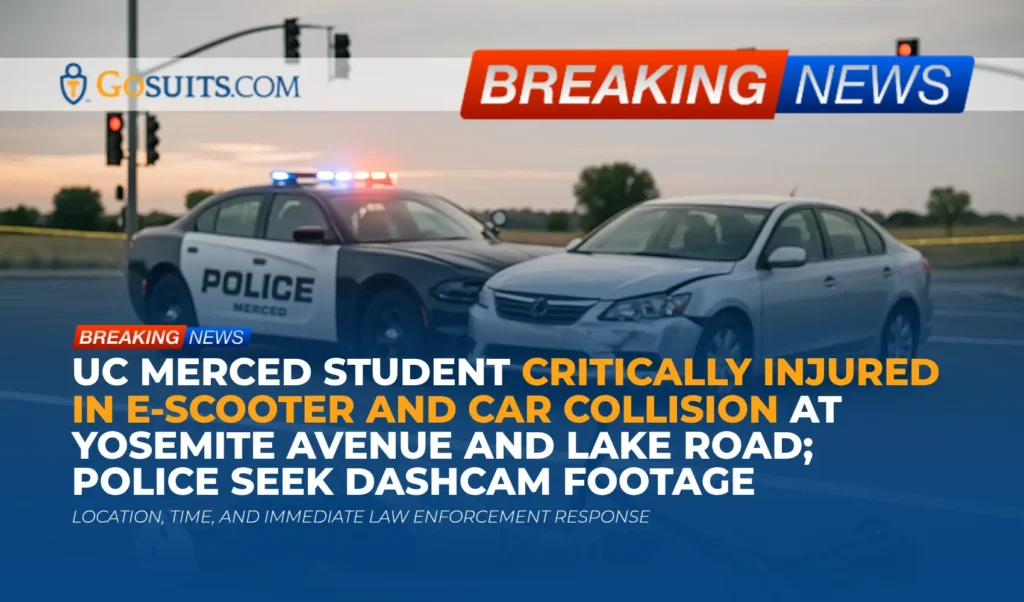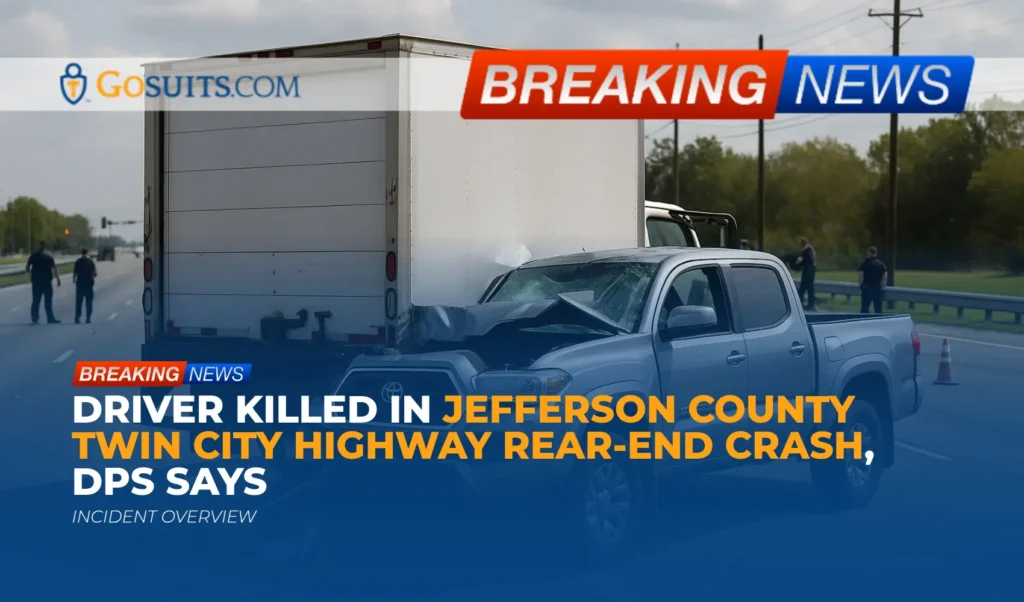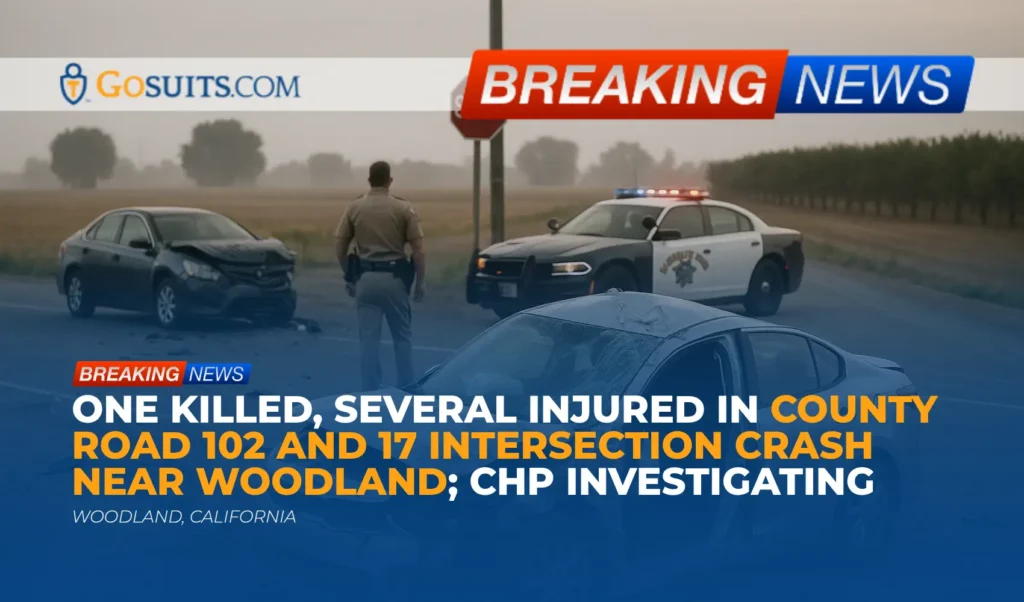- What Happened on IH-610 at Broadway
- What Is Known So Far and What Remains Unclear
- Why Multi-Vehicle Crashes Involving Heavy Trucks Are So Dangerous
- Who Investigates, What Evidence Matters, and How the Record is Built
- How to Get Official Records and Where to Call for Help
- Possible Civil Liability and How Fault Is Evaluated in Texas
- Insurance Issues After a Multi-Vehicle Freeway Crash
- Medical Care, Documentation, and Recovery Considerations
- If a Loved One Was Lost: Autopsy, Records, and Rights
- Practical Next Steps to Protect your Interests
- Commentary from Gosuits Houston, Texas Personal Injury Attorney
- Why Acting Now Matters
- Government and Academic Sources Cited
What Happened on IH-610 at Broadway
Early Monday morning, October 20, 2025, multiple lanes on Interstate 610 at Broadway in Houston were shut down after a heavy truck was involved in a crash that affected five vehicles. Transportation officials reported the lane closures and advised drivers to use alternate routes. At the time these details were made public, there was no definitive information on injuries, and the full circumstances of how the collision unfolded had not yet been released.
Large multi-vehicle incidents on a busy urban loop like IH-610 can create significant hazards not only for those directly involved, but also for people approaching the area, first responders working on-scene, and secondary crash risk due to congestion and sudden slow-downs. Our thoughts are with everyone affected and with the personnel working to safely reopen the roadway.
What Is Known So Far and What Remains Unclear
Confirmed details
- Location: IH-610 at Broadway, within the City of Houston.
- Date and time: Monday morning, October 20, 2025.
- Vehicles involved: A heavy truck and four other vehicles, five total.
- Traffic impact: Multiple lanes were closed while officials responded and investigated.
Information not yet publicly reported
- Injuries/fatalities: Not specified at the time of the traffic alert.
- Cause of the crash: Not yet reported. Potential factors in heavy-truck crashes can include driver decision-making, following distance, speed, mechanical condition, and load securement, but the specific cause here is unknown pending investigation.
- Weather/lighting/road conditions: Not yet reported.
- Whether a hazardous load was involved: Not indicated in initial reports.
As official crash records become available, more definitive details should emerge regarding how the collision occurred and any contributing factors.
Why Multi-Vehicle Crashes Involving Heavy Trucks Are So Dangerous
When a heavy truck is part of a multi-vehicle crash on a high-speed facility like IH-610, the forces involved are substantial. A fully loaded truck can weigh 20 to 30 times more than a standard passenger vehicle, which means stopping distances are longer and crash energy is far greater. In national data, most people who lose their lives in crashes involving large trucks are occupants of other vehicles, underscoring the vulnerability of passenger cars in these collisions. This reality is one reason investigators take these crashes seriously and why it is important to document evidence promptly.
Federal safety oversight for commercial motor carriers also recognizes these risks. There are regulations focused on driver qualifications, hours of service, maintenance, and load securement for motor carriers and drivers operating commercial trucks. Depending on the facts that ultimately emerge in this Houston crash, such rules may be relevant to evaluating fault and responsibility.
Who Investigates, What Evidence Matters, and How the Record is Built
Typical agencies involved
- Local law enforcement: Within Houston city limits, the Houston Police Department generally leads the on-scene crash investigation and will generate the formal Texas Peace Officer’s Crash Report (CR‑3).
- Transportation agencies: State and regional traffic management centers monitor and broadcast lane closures and may maintain traffic cameras. While these systems primarily help manage traffic, they can sometimes be relevant to incident timelines.
- Fire/EMS: The Houston Fire Department typically responds to provide medical triage, rescue, and hazard mitigation, such as addressing fuel spills.
Evidence commonly reviewed after a multi-vehicle truck crash
- Crash scene documentation: Measurements, scene diagrams, photographs, roadway markings, and debris fields help reconstruct vehicle movements.
- Vehicle condition and data: Inspectors may examine brakes, tires, lights, and steering components. Some vehicles have event data recorders; many trucks have electronic logging devices or telematics that record speed and location.
- Electronic logs and carrier records: Motor carriers must retain driver hours-of-service records and certain maintenance records for specified timeframes under federal regulations.
- Driver information: Licensing, medical certification, training, and prior violations are relevant to commercial carrier compliance reviews.
- Witness accounts and 911 audio: Statements from involved parties and independent witnesses, along with dispatch records, help establish a timeline.
- Traffic camera snapshots: Depending on availability and retention policies, some traffic cameras may provide helpful time-stamped imagery.
Key federal record-keeping rules that can matter
- Hours-of-service records: Carriers must retain records of duty status and supporting documents for 6 months. See 49 CFR 395.8.
- Inspection, repair, and maintenance records: Carriers must keep required maintenance records while a vehicle is in service and for a period after it leaves service. See 49 CFR 396.3.
- Driver qualification files: Carriers maintain records of driver qualifications, road tests, and medical certifications. See 49 CFR 391.51.
Because some of these records are only kept for limited periods, timely requests to preserve evidence are important when serious injuries or fatalities are involved.
How to Get Official Records and Where to Call for Help
Police crash reports and records
- Houston Police Department (HPD) Records: For crashes within Houston, the HPD Records Division is the primary contact for police crash reports and related records. Visit Houston Police Department to locate current instructions for obtaining a crash report and other records.
- Texas Crash Reports: The Texas Department of Transportation is the statewide custodian of peace officer crash reports (CR‑3). Guidance on requesting crash records can be found through the Texas Department of Transportation at TxDOT.
Emergency response records
- Houston Fire Department (HFD): For EMS run reports and incident records where HFD responded, see Houston Fire Department for instructions on requesting records.
- 911 audio and CAD logs: Requests for 911 recordings and computer-aided dispatch logs can be made under the Texas Public Information Act. The Texas Attorney General provides public guidance at Texas Attorney General Open Government.
Medical examiner and autopsy records in fatal cases
- Harris County Institute of Forensic Sciences: If a fatality is associated with the incident, families can find information about death investigations and records at the Harris County Institute of Forensic Sciences site.
Traffic camera footage and public records
- Traffic management video: Some traffic camera content may be accessible through public information requests to the appropriate governmental entity. The Texas Public Information Act resources at the Texas Attorney General site explain how to make a request and what exemptions may apply.
When requesting records, include as much detail as possible: date, time window, exact location (IH‑610 at Broadway), and incident number if available. Be mindful that some video systems overwrite quickly.

Possible Civil Liability and How Fault Is Evaluated in Texas
Comparative fault and multi-vehicle crashes
Texas uses a modified comparative fault system. In a civil case, each party’s percentage of responsibility may be assessed based on the evidence. A claimant who is more than 50 percent responsible is barred from recovery under Texas law. See Texas Civil Practice and Remedies Code § 33.001.
In a five-vehicle crash, different forms of negligence can overlap. Examples that investigators examine include unsafe speed for traffic conditions, following too closely, distracted driving, improper lane changes, failure to secure a load, and mechanical defects. For a commercial truck, additional layers can include the motor carrier’s hiring, training, supervision, hours-of-service compliance, and equipment maintenance.
Potentially responsible parties
- Individual drivers: Liability may arise from negligent operation such as inattention, tailgating, or unsafe maneuvers.
- Motor carriers: Employers can be responsible for the actions of their drivers within the course and scope of employment and may face direct liability for unsafe policies, negligent entrustment, and maintenance deficiencies.
- Cargo loaders and shippers: If improper securement or loading contributed, those entities may be considered.
- Vehicle service entities: Repair or inspection errors that contribute to a mechanical failure can be relevant.
- Road owners or contractors: In rare cases, roadway design, signage, or work zone issues may be implicated. Claims against governmental units have specific notice requirements and limitations. See Texas Civil Practice and Remedies Code § 101.101.
Time limits that commonly apply
- General two-year period: In Texas, many personal injury and wrongful death civil actions are subject to a two-year limitation period. See Texas Civil Practice and Remedies Code § 16.003.
- Government notice rules: If a governmental unit may be implicated, the Texas Tort Claims Act generally requires written notice within six months, and some local entities can have shorter deadlines by charter. See § 101.101.
Deadlines can vary by circumstance, so it is important to confirm which time limits apply to a specific situation.
Insurance Issues After a Multi-Vehicle Freeway Crash
Commercial coverage and passenger vehicle policies
Crashes that involve a heavy truck typically implicate a motor carrier’s commercial auto liability policy and, depending on the facts, additional coverages such as motor truck cargo or excess liability policies. Individuals in passenger vehicles may need to invoke their own policies, including medical payments coverage, personal injury protection, collision, and uninsured/underinsured motorist coverages.
Speaking with insurance companies
- Consult an attorney first: Before contacting any insurance company, it is prudent to consult with a qualified attorney for a free consultation to understand rights and obligations. Statements made to insurers can be recorded and used later to limit or challenge a claim.
- Document before you discuss: Organize photos, witness information, medical records, and repair estimates before engaging in substantive discussions.
- Beware of early settlement pressure: Rapid offers may not reflect the full scope of losses, especially when medical prognosis is still developing.
Preserving commercial carrier evidence
Where a commercial truck is involved, a timely preservation letter is often critical to request that the motor carrier retain electronic logging device data, telematics, driver qualification files, maintenance records, and any onboard camera footage. Some of these materials can be overwritten as a matter of routine if not preserved promptly. Federal rules specify minimum retention periods for certain records, but acting early reduces the risk of loss. See 49 CFR 395.8 and 49 CFR 396.3.
Medical Care, Documentation, and Recovery Considerations
Even in crashes where injuries seem minor at the scene, symptoms can evolve over the following days. Back, neck, and head injuries sometimes become more apparent after adrenaline subsides. Documentation is important both for health and for any eventual claims process.
- Seek prompt evaluation: Early diagnosis helps rule out serious conditions and creates a clear medical record tied to the crash.
- Follow through on treatment: Consistency with follow-up appointments and physical therapy supports recovery and creates reliable documentation.
- Keep everything: Save discharge papers, imaging results, prescriptions, mileage to appointments, and any out-of-pocket receipts.
- Track work impacts: Keep records of missed time, modified duties, and employer communications.
If an ambulance transport or fire department aid was provided, obtaining the EMS run report can clarify initial observations, vital signs, and treatment in the field. See the Houston Fire Department for information on requesting records.
If a Loved One Was Lost: Autopsy, Records, and Rights
If a fatality is connected to the crash, families shoulder an overwhelming burden. In addition to funeral arrangements and grief, there are necessary steps to obtain official records and determine what happened.
- Medical examiner information: For deaths within Harris County, the Harris County Institute of Forensic Sciences oversees death investigations and can provide information on autopsy reports, toxicology, and identification processes.
- Death certificates: Vital records are managed by state and county offices; funeral homes often assist with the initial paperwork.
- Crash reports and scene photos: Police records, including the CR‑3 crash report, diagrams, and photographs, can help answer difficult questions about causation.
- Texas limitations period: Wrongful death and survival claims typically must be filed within two years in Texas. See § 16.003.
Families may also consider appointing a representative to handle records requests and communications, which can make the process more manageable during a painful time.
Practical Next Steps to Protect your Interests
- Document the scene and vehicles: If it is safe and feasible, photograph damage, license plates, final rest positions, skid marks, debris, and any visible roadway defects or obstructions.
- Identify witnesses: Collect names and contact information for independent witnesses. Their accounts often carry significant weight.
- Request official records promptly: Crash reports, 911 audio, and EMS records can be requested from the appropriate agencies listed above.
- Preserve electronic evidence: Save dashcam footage, phone photos, and location data. For commercial carriers, consider sending a preservation request addressing ELD and telematics data.
- Avoid detailed insurer statements before counsel: Early statements can be used to minimize or dispute claims. Consult an attorney first for a free review of rights and options.
- Track all expenses: Maintain a folder with medical bills, co-pays, repair invoices, towing, rental car receipts, and lost wage documentation.

Commentary from Gosuits Houston, Texas Personal Injury Attorney
We extend our care and sympathy to everyone affected by the multi-vehicle crash on IH‑610 at Broadway. Incidents like this can upend daily life in a matter of seconds. This article is shared for educational purposes and general information to help the community understand the process that follows a serious roadway collision.
Based on what is known, a heavy truck and four other vehicles were involved, and multiple lanes were shut down. When a commercial truck is part of a multi-vehicle collision, it is important to consider a broad range of factors. Investigators typically look beyond driver actions to also assess carrier practices, equipment condition, and whether traffic flow or sudden slow-downs contributed. The responsibility picture in a five-vehicle event can be complex, and accurate conclusions depend on careful evidence gathering, from crash scene measurements to electronic logging data and maintenance records.
Insurance companies and large corporate risk departments move quickly after crashes to limit exposure. Their adjusters and investigators are trained to collect statements that can later be used to minimize claims and to frame the narrative in their favor. Information asymmetry is real: many people do not know what documents to request, how long key data is retained, or which rules might apply to a carrier’s operations. A free consultation with a seasoned attorney can level the playing field by clarifying rights, identifying critical evidence before it is lost, and helping to avoid missteps that could impair a future claim.
Why Acting Now Matters
- Time-sensitive evidence: Electronic logging device data, onboard camera footage, and traffic management video can be overwritten in days or weeks. Early preservation requests reduce the risk of losing vital proof.
- Medical clarity and documentation: Prompt evaluation helps connect symptoms to the crash and builds a reliable record, which supports both health outcomes and later claims.
- Legal deadlines: Texas law sets filing deadlines for personal injury and wrongful death claims, and notice to governmental entities can be required within a limited window. Missing a deadline can limit or eliminate recovery options.
- Insurance positioning: Insurers often engage quickly, seeking statements or offering early settlements. Understanding rights before engaging helps avoid outcomes that do not reflect the full extent of losses.
- Financial stability during recovery: Organizing benefits, medical billing, and vehicle repairs early can ease the practical burden and help prevent avoidable credit or employment complications.
To move forward effectively: identify the correct agencies for records, gather and preserve your own evidence, obtain a free consultation before giving recorded statements to any insurer, and keep thorough, contemporaneous documentation of medical treatment and expenses. Acting within days rather than weeks often makes a measurable difference in the completeness of the evidence available.
Government and Academic Sources Cited
- 49 CFR 395.8 (Hours-of-service; record retention)
- 49 CFR 396.3 (Inspection, repair, and maintenance)
- 49 CFR 391.51 (Driver qualification file record retention)
- Texas Civil Practice and Remedies Code § 33.001 (Comparative responsibility)
- Texas Civil Practice and Remedies Code § 16.003 (Two-year limitations period)
- Texas Civil Practice and Remedies Code § 101.101 (Notice requirements for governmental units)
- Houston Police Department (Crash and records requests)
- Houston Fire Department (EMS and incident records)
- Harris County Institute of Forensic Sciences (Medical examiner records)
- Texas Attorney General Open Government (Public information requests)
- Texas Department of Transportation (Crash records and statewide roadway information)
- National Highway Traffic Safety Administration (Traffic safety context for large truck crashes)






